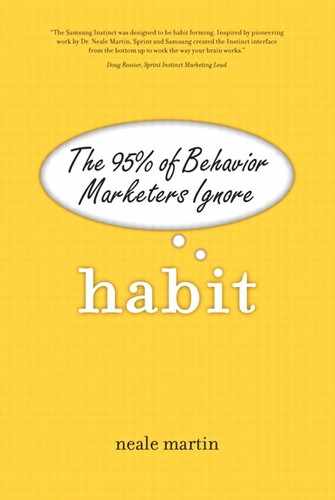Conditioned Reinforcers to the Rescue
Pryor is a strong advocate of clicker training, in which a click is paired with a reinforcer multiple times until the click becomes a conditioned reinforcer. If a dog hears a click just before getting a cookie, it associates the click with the cookie. The habitual mind is not learning simply how to get food, but how to get along in the environment. Conditioned reinforcers are just another way of forming shortcuts, making them useful for building habits.
For example, because it can take a long time to earn a trip with frequent flyer miles, airlines could develop a conditioned reinforcer. Imagine receiving an auditory or visual cue at the airport kiosk at check-in. A small chime or visual representation could signal travelers that the trip they are taking is getting them close to a free trip or merchandise. This immediate feedback would strongly reinforce my airline choice. The future trip is a reward that lives only in the executive mind; the click would become a reinforcer for the habitual mind.
Pryor is adamant that using positive reinforcement is the best way to work with people, dogs, horses, and even fish. “Whether you’re working with animals or people, positive reinforcement is far more humane and respectful than any of the alternatives, such as punishment or coercion. It’s also far more effective.”
I think a profound error for us as managers, parents, and marketers is not appreciating which mind we are working with. In raising children, parents want to instill strong morals and ethics. They want their children to be honest, thoughtful, hard working, and conscientious. But they yell at them for not keeping their rooms clean and not washing the dishes. In the minds of parents (myself definitely included), confusion exists between bad behavior (lying, stealing, bullying) and poor training (not keeping a room clean, failing to study for a test). Although picking up your clothes in not an ethical issue, we make it so by treating our children’s failure in this area as a sign they’re being bad. A lack of proper training is a failure of habit, not of morals.
The same concept is muddled in our heads when we describe customer loyalty. The word loyal carries an exceptional amount of baggage. If you are a disloyal spouse or a disloyal soldier, you have violated the sacred cannons of important societal institutions. Should we really think that our customers owe us this kind of loyalty? If your customers aren’t loyal, it means that they have not been properly trained, not that they have violated a code of conduct.
Customers are using your product, service, store, web site, or search engine to solve their problems. Training them means you are helping them become more efficient in getting their tasks done by using your company. As I described the idea behind this book to Pryor, she laughed and said, “You’re right. The reinforcer is not having to think about it. I don’t know the brand of detergent I buy; I just know it’s the one in the blue bottle.”
Instead of being manipulative, using behavioral conditioning with reinforcers and conditioned reinforcers lets people know exactly what is expected of them. It also puts them in control of the situation. Many of us have experienced the frustration of dealing with insurance companies that seem to arbitrarily disallow services we think our policy should cover. As companies become more global, they create layers of insulation between themselves and their customers, inhibiting the two-way feedback mechanisms that can ensure long-term, profitable relationships.
